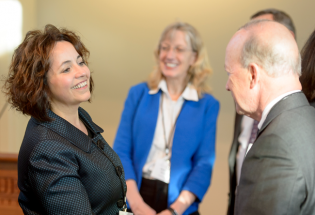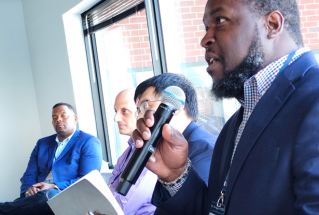Redefining Academic Success: PTIE’s Mission for Modern Promotion and Tenure
Feb. 27, 2024 —Promotion and tenure (P&T) are key elements in academic career paths, providing recognition for achievements, job security, and stability. However, the criteria for evaluating faculty for P&T has historically focused on research publications, awards, and teaching/mentorship, with less emphasis on other important aspects of professors’ work—namely, innovation and entrepreneurship. To advocate for more inclusive P&T guidelines, the National Science Foundation-funded Promotion & Tenure – Innovation & Entrepreneurship (PTIE) has worked to create recommendations for universities to implement in their own P&T policies. The initiative has also created a coalition of universities dedicated to being a part of the conversation surrounding P&T.
—Promotion and tenure (P&T) are key elements in academic career paths, providing recognition for achievements, job security, and stability. However, the criteria for evaluating faculty for P&T has historically focused on research publications, awards, and teaching/mentorship, with less emphasis on other important aspects of professors’ work—namely, innovation and entrepreneurship. To advocate for more inclusive P&T guidelines, the National Science Foundation-funded Promotion & Tenure – Innovation & Entrepreneurship (PTIE) has worked to create recommendations for universities to implement in their own P&T policies. The initiative has also created a coalition of universities dedicated to being a part of the conversation surrounding P&T.
General guidelines
Often, P&T guidelines in academia are centered around several core aspects of a professor’s work, including research, teaching, and service. Research achievements are typically measured by an interrelated combination of external grant funding, peer reviewed-publications (and their subsequent citations by others), and external letters of evaluation from leading faculty at other institutions. Teaching recognition can be measured through student and peer evaluations, curriculum development, and information about students the individual has mentored or advised. Service requirements often consider leadership positions, committee work, or professional activities. Guidelines vary from institution to institution, with some emphasizing guidelines that align with institutional initiatives and priorities. Because tenure is highly prized, P&T guidelines that do not offer an inclusive definition of research (scholarship) and funding can deprioritize societally-impactful work by faculty that is called for in university mission statements and strategic plans, as well as by society at large.
That emphasis gives short shrift to other valuable outcomes that can impact the institution and society more broadly. The PTIE initiative seeks to include and recognize the role of innovation and entrepreneurship as well, rewarding faculty who contribute to societal impact through technological advancement, start-up creation, and the commercialization of research findings. By recognizing metrics like intellectual property, sponsored research that includes SBIR, STTR, innovation & entrepreneurship (I&E) funding, entity creation, use and licensing, I&E career preparation, and I&E community engagement, more I&E-inclusive P&T guidelines can encourage academics to pursue projects beyond publication—many of which include partnership with industry.
PTIE progress
PTIE initiated a national dialogue surrounding innovation and entrepreneurship considerations in P&T guidelines. In 2020, it convened representatives from institutions across the country to develop actionable recommendations for universities to recognize innovation and entrepreneurship in P&T. Rich Carter, professor of chemistry, faculty lead for innovation excellence at Oregon State University, and PI for the PTIE effort, pointed to culture change as a key motivator for consideration of the new guidelines.
“I think global culture is changing, and more and more people are wanting to be mindful of having societal impact in their work,” Carter said. “People don’t just want a paycheck—they want to make a difference.” Carter’s university is among several that have adopted elements of the PTIE guidelines already, although the process of change is necessarily slow; faculty dedicate years to building their tenure case, and change requires time.
Carter also likened this mindset to the students coming to universities—with 60% of college grads looking at entrepreneurship as a career path. “There are many people seeking out these sorts of skills that are coming to universities, and the most important output of a university is the people we produce. So the training mechanism is very important.” Encouraging innovation and entrepreneurship activities through P&T recognition gives more credibility to talented faculty, and that in turn can be a draw for potential students.
Carter notes a shift toward support for PTIE efforts among funding agencies as well. In the National Science Foundation’s Accelerating Research Translation (ART) program, the solicitation reads, “Translational research activities at ART awardee institutions should be treated on par with fundamental research activities in faculty recruitment, tenure, and promotion decisions.” As agencies fund more translational research programs, there will likely be other efforts that champion the aims of the PTIE guidelines and recommendations.
Carter credits an article by Paul Sanberg that catalyzed the movement for valuing innovation and entrepreneurship in career advancement, and data from Elsevier also shows that articles published with industry have higher citation impact. “Analysis found that faculty who engage with industry publish in higher impact journals, are more cited, receive more grants, win more awards, and get better jobs,” he said. “That publication laid the foundation for PTIE. Without that data to show that faculty who do this aren’t going to be negatively impacted in their career long term, I don’t think any of this would be possible.”
Why it matters
PTIE’s work to include innovation and entrepreneurship in P&T guidelines, coupled with the broader shift toward inclusive career advancement practices for faculty, signal a broader movement in academia’s recognition of faculty contributions. Rewarding innovation can help universities align with market needs and position them to solve large-scale challenges, as well as create an environment to attract students and faculty alike.
We want to hear from you. What do you think about including innovation and entrepreneurship in promotion and tenure guidelines? Let us know on our LinkedIn profile.


